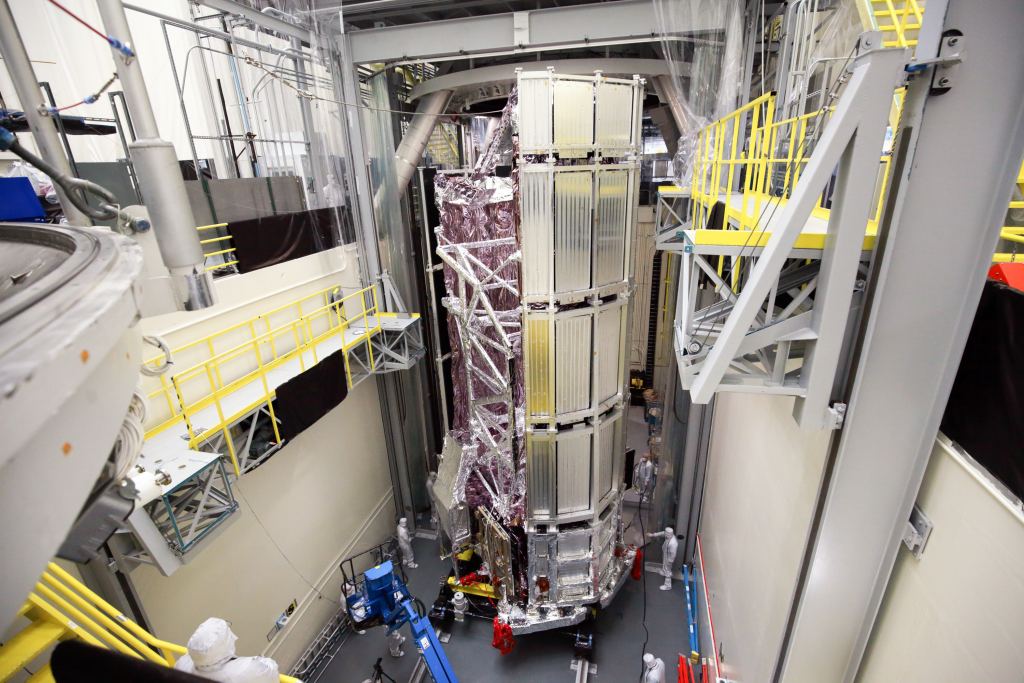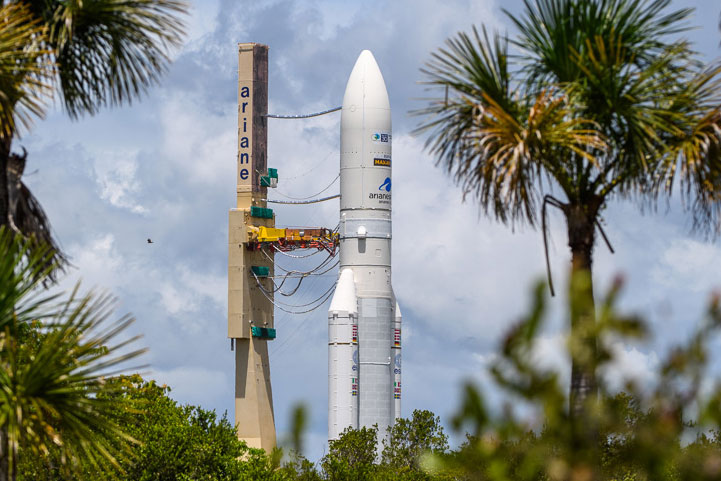A new report from the US Government Accountability Office (GAO) says that the launch of the long-awaited, highly anticipated James Webb Space Telescope (JWST) will very likely be delayed due to an anomaly identified in the Ariane 5 launch vehicle. Launch for JWST is currently scheduled for October 31, 2021, but that date could slip by at least a couple of weeks.
As we reported yesterday, the usually reliable Ariane 5 has experienced problems on two previous launches where unexpected vehicle accelerations occurred when the fairing separated from the rocket. The fairing is the nose cone used to protect a spacecraft payload during launch and acceleration through Earth’s atmosphere.
The Ariane 5 has been grounded for several months while the European Space Agency and Arianespace investigate the issue. In both anomalies, the payloads were successfully placed in orbit, however. There are two Ariane launches on the manifest before the JWST launch, and those launches are now expected no earlier than June and August 2021, respectively.

During a media briefing on May 11, Greg Robinson, Program Director for JWST at NASA’s Science Mission Directorate said that ESA and Arianespace are going through the process of getting the rocket ready for the upcoming first launch, and once the first launch takes place, “we’ll be able to launch in about four months after that.”
The two Ariane 5 launches are scheduled to carry the Eutelsat Quantum satellite and Star One D2 satellite.
The GAO report, released on May 13, 2021, said that Arianespace must demonstrate that the issue has been corrected on at least one of those launches before JWST will be allowed to launch. As of now, “the JWST launch had not been rescheduled; however, project officials assessed the risk that the JWST launch date could be rescheduled as highly likely. The project has received briefings on the investigation’s progress from its international partners and is continuing to monitor the situation.”
NASA officials at the media briefing this week admitted that the margin in their schedule in preparing and shipping JWST to South America is basically zero.
“When we ship, the schedule margin will be pretty close to zero, but still on plan,” Robinson said, “Right now, we are not working any liens, and we’re in a really good place.”
The GAO report indicated the JWST project has used schedule reserves—extra time set aside to accommodate unforeseen risks or delays—faster than expected to address issues such as repairing and strengthening the sunshield.
“As a result, the project has less schedule reserve than planned to complete remaining activities,” the report said. “The project is also completing redesigns for key parts of the observatory, including actuators, which help unfurl the sunshield. Further, the project continues to address technical problems that could affect the project’s ability to meet cost commitments if the contractor workforce is needed longer than planned.”
Including the launch delay risk, the report said JWST project managers are working on managing 39 risks. Of the 39 risks, NASA will continue to manage 26 after launch, including those related to sunshield deployment and the functionality of the observatory’s sensitive, near-infrared camera.
Alarmingly, some of these risks could result in loss of mission, but NASA has assessed that they are unlikely to occur.

As is well known, the JWST program has a history of significant schedule delays and project cost increases. The entire project was replanned in both the 2011 and 2018.
“Since the project’s schedule and costs were baselined in 2009,” the GAO report says, “the launch date has been delayed by over 7 years and costs have increased by 95 percent. Due to early technical and management challenges, contractor performance issues, and low levels of cost reserve, the JWST program experienced schedule overruns, launch delays, and cost growth.”
But recently, the project has completed significant technical milestones, such as successfully completing the final set of acoustics and vibration testing in October 2020, and performing sunshield deployment exercises in December 2020.
In a mission that has seen significant postponements, it seems an iconic irony that now as JWST seems finally ready to launch, it might experience another unexpected delay.


Would it fit on a Falcon 9 Heavy?
No. Ariane 5 has the largest payload fairing, or nose cone, at 5.4 meters across. Falcon 9’s is 5.2 meters. Webb’s 6.5-meter mirror, which consists of 18 hexagonal segments arranged like a honeycomb, has three segments on each side that fold back for launch so the telescope can fit. It has been configured to fit snugly in the Ariane 5, and wouldn’t fit in the Falcon 9.